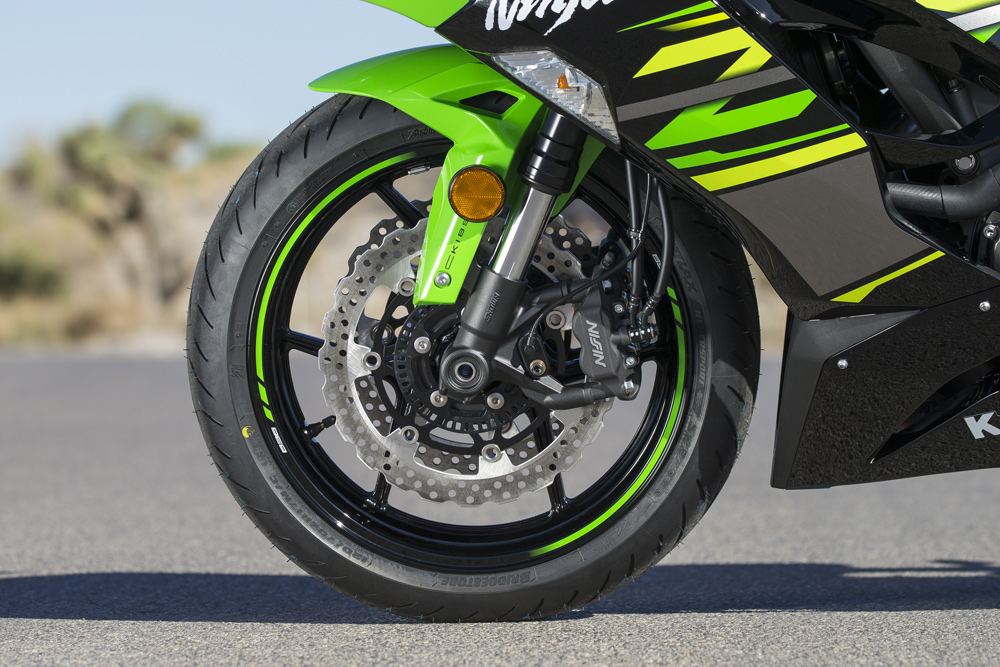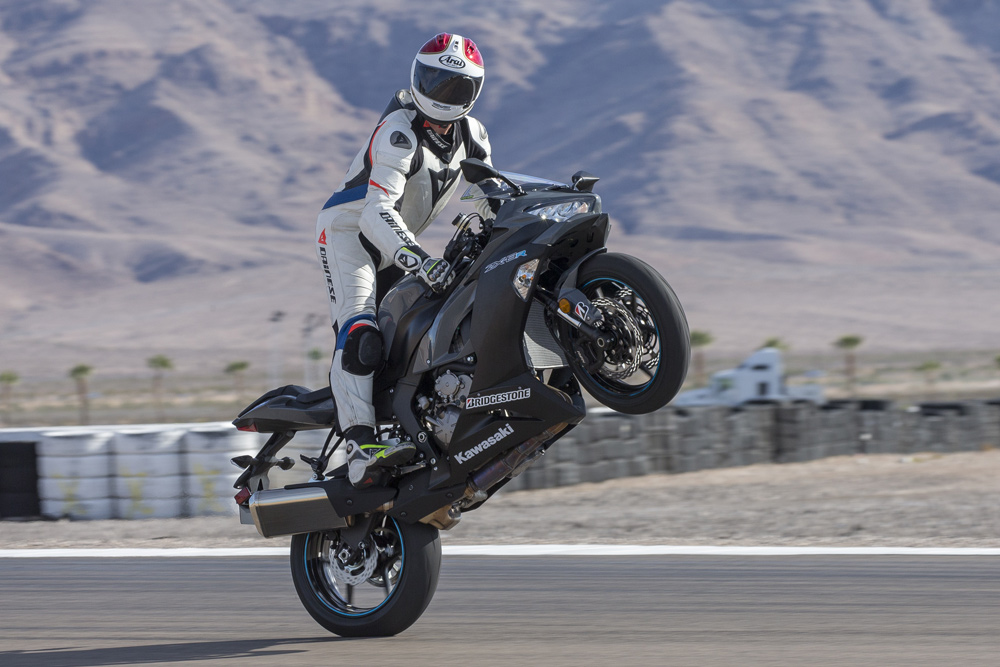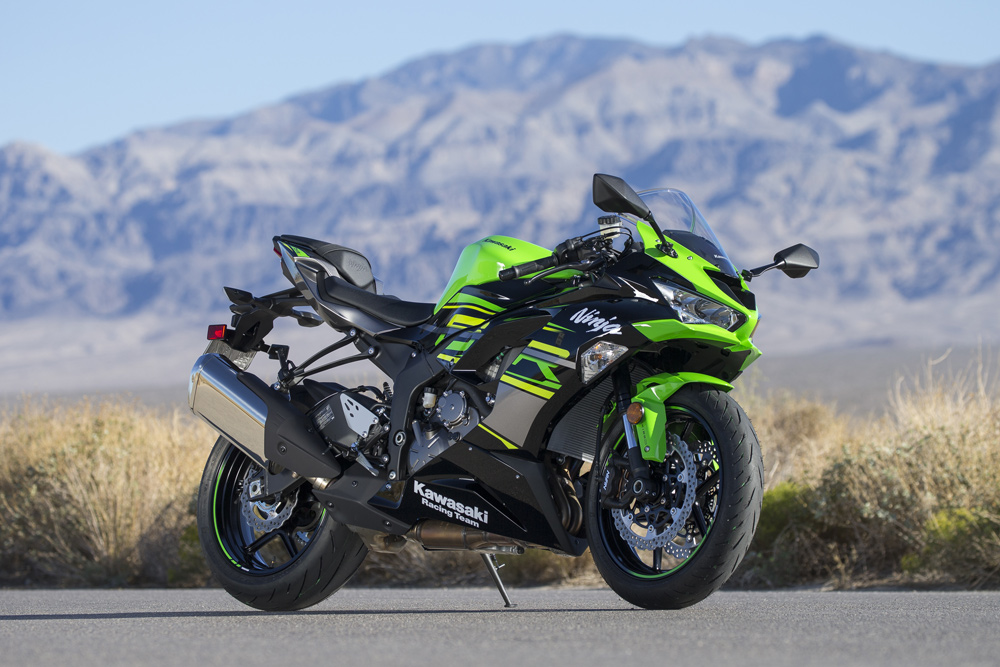Rennie Scaysbrook | October 25, 2018
Same, Same, But Different
It’s been a long time since we’ve thrown a leg over a Kawasaki ZX-6R. Is it still as good as we remember as we head into 2019?
 As a street bike that can double as a track-day steed, the ZX-6R is one hell of a bike.
As a street bike that can double as a track-day steed, the ZX-6R is one hell of a bike.
It’s an interesting market, the old supersport one. On one hand, you’ve got some people saying it’s a dead segment, one that should quietly go the way of the 750cc class and confine itself to history. Their arguments often stem from the fact 600cc motorcycles don’t have enough torque to make for a good street bike and require too many revs to keep them going in traffic, among other things.
Then you have the other side—the die-hard sportbike lovers who kneel at the altar of corner speed and pray to the god of late braking, and who know there is very little on this planet that can keep up with a well ridden 600.

Photography by Kevin Wing
There’s no denying the supersport market is a pittance of what it once was. After all, Honda, the world’s biggest manufacturer, doesn’t even have a new CBR600RR for sale in the U.S. and soon won’t have one in Europe thanks to the ever-tightening emissions laws that strangle the rev happy four-cylinder.
But there’s an argument far more applicable to supersport riders than whether polar bears have somewhere to chill—and that’s price. The cost of a modern 600 is not that far off what a superbike costs, making the bang for buck ratio a difficult one if all you’re after is the fastest bike for the cheapest price.
For example, last year the 636cc Kawasaki ZX-6R would set you back $11,699 for the non-ABS version, with the company’s flagship ZX-10R retailing for $15,399. A difference of $3700 for what is almost double the motorcycle in terms of outright horsepower hasn’t sat very well with riders, so for this year Kawasaki has come back with a revised—although mechanically very similar—ZX-6R and lopped a massive $1699 off the retail price to get it under the magic $10K marker and bring the bike back to the kind of price supersport machines enjoyed in their heyday of the mid-2000s.
 A line of Ninjas: The press could have any bike they liked, as long as it was green. The LED lights make the 600 look rather mean.
A line of Ninjas: The press could have any bike they liked, as long as it was green. The LED lights make the 600 look rather mean.
Under the Hood
“The supersport market is still incredibly important for us at Kawasaki,” says Kawasaki USA’s Brad Puetz. “We realize the price was a barrier to many riders, and we want to keep people excited about this segment because these bikes, unlike 1000s, are ones that a wider range of riders can get the most out of on the track and street. The motorcycle industry needs the supersport segment, and we want to see it grow.”
Keeping people excited is a difficult endeavor, however, and you can’t do that with just the same bike, even if the price is reduced. As such, the 2019 Kawasaki ZX-6R is more a case of new clothes than any performance gains riders will notice, with all-new styling with looks ripped closely off the baby Ninja 400 with LED lighting front and rear; new dash; a reshaped seat that’s skinnier where it meets the tank and shorter front to back; the fitment of the Kawasaki Quick Shift system for clutchless up (not down) gearshifts; shorter gearing to further enhance low-end performance and Bridgestone’s excellent Battlax Hypersport S22 tires as standard fitment. It’s not the full makeover many riders had hoped for, considering the success of the company’s ZX-10R on the street and track, but the changes wrought show Kawasaki isn’t backing away from a segment it once dominated with its eyes shut.
 On the KRT edition, the rear spring is green. It makes it more Kawasaki that way.
On the KRT edition, the rear spring is green. It makes it more Kawasaki that way.
What’s carried over is what we know from 2013: an inline four-cylinder engine punched out to a supersport racing-illegal 636cc that now Euro4 compliant; a slip and assist clutch; the same twin-spar aluminum chassis and suspension provided by Showa in the fully adjustable SFF-BP (Separate Function Fork – Big Piston) fork and rear shock; and brakes by Nissin in the four-piston caliper. ABS is a separate feature for an extra $1000, meaning even the ABS-equipped model is still dramatically cheaper than it was last year.
 Dash has come in for a rework and now comes with fuel range and remaining fuel.
Dash has come in for a rework and now comes with fuel range and remaining fuel.
As for the electronics, it’s the same as before with two engine modes of Full and Low power, plus ABS and three stage traction control—Kawasaki was the second bike in the supersport class to fit TC behind the Italians at MV Agusta in 2013.
 The Showa suspension on the road is excellent, offering great bump absorption and rider comfort.
The Showa suspension on the road is excellent, offering great bump absorption and rider comfort.
Vegas, Baby
The city of Las Vegas is not known for its excellent street riding characteristics, so it seemed an odd place to launch a bike whose main m.o is corner and apex slaying. But Las Vegas is nothing if not surprising, and riding the new ZX-6R with ABS into Mt. Charleston made the scorching desert where most go to lose the fortunes look more like northern Washington as we passed ski villages and logging cabins.
On the street, you’re reminded why Kawasaki gave the engine that extra 36cc, as the low- to mid-range torque is a welcome change from the lack of initial punch commonly found on supersport machines. On top of that, the shortened gearing doesn’t feel like it’s sacrificed the top end, as you still get a solid power rush once the needle swings past that 10K rpm mark.
 The Nissin brakes are a carryover from the 2013 ZX-6R.
The Nissin brakes are a carryover from the 2013 ZX-6R.
The engine is the best compromise of supersport and superbike performance currently available from the Japanese. There’s a beautiful throttle connection and fuel-injection mapping with the ZX-6R and almost no snatch on small twist grip openings, so you can precisely dial in the amount of throttle you want and know that’s what you’re going to get.
The ZX-6R already had a smooth gearshift prior to 2019 but the fitment of the Kawasaki Quick Shift system gives lightning quick gear changes, even if there’s no auto-blipper for clutchless downshifts.
Ergonomically, the ZX-6R feels the same as before even though the seat is a touch narrower. The rider still gets a decent slant forward, so you’ll start to feel it on wrists after 45 minutes on board. It’s a supersport bike, after all, so if you want long range comfort you might want to look at something like a Z900.
 A new seat unit is shorter front to back and narrower.
A new seat unit is shorter front to back and narrower.
The Showa SFF-BP fork is easily one of the best on the market when it comes to street comfort. It’s a soft action to begin with, only ramping up as you really start to hammer the brakes from high speed. The ZX-6R, coupled with the Bridgestone S22 rubber, will carve and hold lines beautifully at speed. This is an excellent tire with plenty of grip for dealing with the various changes in pavement and camber and helps the suspension filter out many of the micro-shocks before they hit the rider.
 The clutch lever is now span adjustable.
The clutch lever is now span adjustable.
On Track
Transferring to the racetrack at Las Vegas Motor Speedway, the ZX-6R—now in non-ABS and costing that magic $9999—is still as potent a weapon as it was before Kawasaki lopped the price off it.
VIDEO | 2019 Kawasaki Ninja ZX-6R First Test
We traded the Bridgestone S22 for the company’s track-special DOT race R11 tires that we used on the Yamaha YZF-R1M and YZF-R6 test earlier this year and tires that are firmly in the top three of our favorite track hoops available to the public.
What stands out on track is how user friendly the ZX-6R chassis is, rather than the quickness of engine. At a claimed curb weight of 428 pounds, the Kawasaki is not the lightest supersport machine out there and as such doesn’t turn with quite the speed of some class rivals, but through the wicked-fast turn-seven right hander, taken at mid throttle in fifth gear, the ZX-6R was as solid as a rock. High-speed stability has often been a ZX-6R strongpoint, and this one is no different—simply because, mechanically speaking, this is the same bike it was before.
 Even though the Las Vegas track munched them to pieces, the Bridgestone R11 track tires performed brilliantly, if only for two seasons before they needed replacing.
Even though the Las Vegas track munched them to pieces, the Bridgestone R11 track tires performed brilliantly, if only for two seasons before they needed replacing.
Through tight sections of track the ZX-6R doesn’t love changing lines at the last second—it’s more a case of pick your line and stick with it, especially compared to something like an MV Agusta 675 F3 that feels like you can change lines just by thinking about it. The ZX-6R’s stability is one of its strongpoints, and will reward a smooth rider that thinks of the line early, sets up and powers through it, rather than changing his mind on his line at the last second.
Repeated hard track use will see a bit of fade creep into the braking system as the ZX-6R doesn’t have steel brake lines, but overall the power is good. Kawasaki has not changed the braking system for many years on the ZX-6R, so you’ll get the same conventional master-cylinder that doesn’t have the quite precise feel at high speed offered by some class competitors. Still, for a bike costing under $10K, the braking package is more than up to the task.
 No, this is not Washington, it’s Nevada, about 70 miles from Vegas. Seems wrong, we know.
No, this is not Washington, it’s Nevada, about 70 miles from Vegas. Seems wrong, we know.
It’s hard to argue with the extra 37cc on track, especially in slow-speed squirts from one corner to the next as the extra low and midrange performance gives it a distinct advantage over the rest of the four-cylinder Japanese supersport contingent. You can be a little lazy with the ZX-6R and it’ll soak it up and drive you forward through the midrange and into the top-end as you dance on that quick shifter, snatching gears with the throttle pinned.
Kawasaki’s traction control system isn’t the most advanced currently available, but it does a good job of keeping everything in check and on line. It takes a decent amount of throttle to get the system working in mode one, allowing the rider more connection than in levels two or three. Switching it off is still the way to go on track, however, as it’ll give you that 1-1 throttle and wheel connection track riders crave.
 Hey Josh Herrin, am I doing it right?
Hey Josh Herrin, am I doing it right?
In all, the ZX-6R is still a solid track weapon, even though it’s the street where this thing really shines. When you strip back the new bodywork, LED lighting, the quick shifter, revised dash, and shorter gearing, this is the same bike it’s been for the last six years—only with a price tag that’s by far the best in the class. This is still an excellent motorcycle for sportbike riding, and even though it’s not entirely new, it’s good to see Kawasaki still breathing some life into a segment many have said is headed for the grave. CN
A Trip Down Memory Lane
Let’s check out just how we got to the 2019 ZX-6R. Kawasaki is one of the original supersport pioneers, having started with an inline four way back in 1985.

1985—Kawasaki ZX 600-A1
The OG. The ZX 600A-1 bought the supersport market into focus, right at the time Suzuki bought the modern superbike to market with the GSX-R750.

1990—Ninja 600-C3
The first Kawasaki 600 to come with ram air. The 1990 600-C3 also got a new chassis and different styling, bringing it closer to line with the ZX-10.

1995—Ninja ZX-6R
The first Kawasaki 600 to be christened the ZX-6R. The name change bought with it a completely redesigned motorcycle, one that weighed 27 lb less than the current model. It arrived at the beginning of the golden years for supersport racing and dominated the world over.

1998—Ninja ZX-6R
The G-series Ninja hits the stands with new bodywork and more power from the 599cc inline four.

2003—Ninja ZX-6R
One of the biggest changes in ZX-6R history. Kawasaki punches the displacement out to 636cc with a new long-stroke motor. It also brings out the first ZX-6RR designed for racing, so now Kawasaki has the best of both worlds.

2005—Ninja ZX-6R
More power, a revised frame, swingarm, fairing and the first under seat exhaust we’ve seen Ninja (the ZX-10R followed the next year in 2006).

2007—Ninja ZX-6R
Reverts back to 599cc and just a single model (no RR edition). As such we get a totally revamped machine, with a new motor and chassis as well as slimmer bodywork. Roger Hayden uses it to clinch his only national title in AMA Supersport.

2009—Ninja ZX-6R
The 6R goes on a diet and loses a bunch of weight, gets a new bodywork design that debuted on the ZX-10R in 2008, new suspension and brakes, and more power from the 2007-spec motor.

2013—Ninja ZX-6R
Kawasaki brings the 636cc motor back into production, and gave the motor more power than before, while the chassis was revised and new bodywork fitted. Also came with traction control and variable rider modes.

| SPECIFICATIONS |
2019 Kawasaki ZX-6R ($9999/$11,699 ABS) |
| Engine: |
Liquid-cooled, inline 4-cylinder, 4-stroke |
| Displacement: |
636cc |
| Bore x stroke: |
67 x 45.1mm |
| Fuel injection: |
Electronic fuel injection system |
| Transmission: |
6-speed cassette |
| Clutch: |
Wet, Multiplate, slip and assist |
| Chassis: |
Twin spar aluminum |
| Front suspension: |
41mm Showa SFF-BP, fully adjustable |
| Rear suspension: |
Showa monoshock |
| Front wheel travel: |
4.7 in. |
| Rear wheel travel: |
5.9 in. |
| Front brake: |
Dual 320mm discs with 4-piston radially-mounted Nissin caliper; ABS optional |
| Rear brake: |
Single 220mm disc with 2-piston caliper, ABS optional |
| Front tire: |
120/70 ZR17 in. |
| Rear tire: |
180/55 ZR17 in. |
| Wheelbase: |
55.1 in. |
| Seat height: |
32.7 in. |
| Fuel capacity: |
4.5 gal. |
| Weight: |
428 lbs; 430 lbs. ABS |
| Colors: |
Lime Green, Ebony, Metallic Graphite Gray KRT Edition |